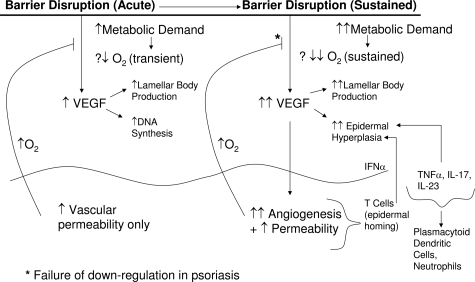Figure 7.
Potential role of epidermal VEGF in normal permeability barrier homeostasis and in psoriasis. Hypothetical scheme for regulation of epidermal VEGF in response to acute barrier disruption (left). Transient hypoxia (?↓O2) stimulates VEGF production, which stimulates vascular permeability. Re-oxygenation of epidermis then down-regulates VEGF production. In psoriasis, a sustained barrier abnormality results in even more intense metabolic activity, with a further reduction in tissue oxygen levels (shown as ?↓↓), leading to sustained production and increased levels of VEGF. Sustained VEGF overproduction, in turn, leads to epidermal hyperplasia, a superabundance of lamellar bodies, and the prominent capillary abnormality in psoriasis. According to this scheme, the TH1 infiltrate in psoriasis is recruited downstream in psoriasis, but it can further drive epidermal hyperplasia.

